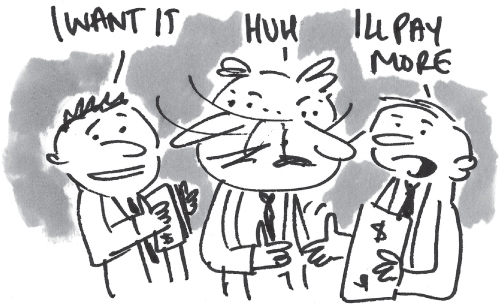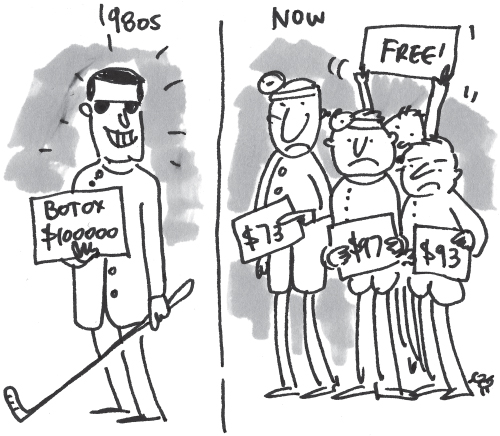PRINCIPLE 1
DEMAND AND SUPPLY SET THE PRICE
You likely learned long ago that the market forces of demand and supply determine the price and the profit you'll make. But what you didn't learn is that you can make your own market forces.
THE STORY OF THE TWO BIDDERS
I was in a room with 400 people who had come to see renowned entrepreneur and author Gary Vaynerchuk share his ideas on social media marketing. He announced at the end of his presentation that he'd be auctioning off a 1-hour one-on-one business consultation with him and the proceeds would go to charity.
He explained that the last time he did a consultation like this he had made several introductions to his network and the person had made an additional $50,000 in less than 30 days. ‘It's not just a consultation’, he explained. ‘It's potentially access to my network – and I know some of the world's most powerful people.’
This had put the audience into a state of frenzy. I opened the auction with a bid of £500 and immediately another person took it to £600. Within a flash the price hit £1000 and the hands kept popping up.
Bids were coming in thick and fast. £2000, £2200, £2400, £2600, £2800.
As the bidding passed the £3000 mark, it came down to two men who clearly both wanted this prize. Everyone else was out of the race, but these two guys kept matching each other and taking the price up another £100 each time.
They were the only two people still bidding in a room with 400 individuals. The rest were sitting patiently or enjoying the spectacle.

The price got up to £3900 with no signs of slowing down. Gary could tell the audience members were getting restless – so he asked the two bidders, ‘Will you both pay £4000 each and I will provide a consultation for both of you?’
They agreed, and the hammer went down. Gary had raised £8000 by auctioning off two hours of his time.
I'm not sure how high it would have gone, but I do know that it only takes two people to push up the price at an auction. Most of the people in the room didn't bid at all and very few people bid beyond £1500. But that doesn't matter. When the supply is ‘one’ and there are ‘two’ who want it, then the price keeps going up. Two people who desire something is enough to oversubscribe the one person who has it. The price keeps going up until one entity gives in.
When Facebook purchased cross-platform mobile messaging app WhatsApp for $19 billion, the number seemed ridiculous to almost everyone on the planet – except one other bidder. Google was the other company who wanted to buy WhatsApp and the two rival companies bid the price into the stratosphere. Had the price been set by a wider market, the general consensus would have been a much lower number.
Too many business owners focus on the entire market place. They are deeply concerned with what the majority will pay rather than finding the small group of people who really value what they offer. But if you focus on the wider market price, you'll always be average.
If Gary Vaynerchuk wanted to try and sell everyone an hour of his time during the auction, he would probably have needed to lower his price to £200 per hour. And after delivering a month of solid consultations to all 400 people he also would have needed a holiday – and would have had zero energy to write more books or give more talks.
As it turns out, Gary knew that his real value wasn't even the consultation. It was his ability to make a high-level introduction that would be taken seriously because it came from him.
Your value is much higher than you think to a small number of people. You don't need everyone on the planet to see you as in demand; you only need enough people who can drive your price up. Separating from the economy and from your industry requires that you turn your attention to those people who find you highly valuable – and then serve them better than anyone else can.
If two people want your time and only one can get it, your price rises until one of them gives in. Your job isn't to please everyone. Your job is to find those people who can't live without you. So… who are those people? What is it they want? And where do you find them? These questions matter more than the questions that relate to the overall market.
Your price isn't fixed, or set by the overall market. It's a result of being oversubscribed or not.
Let's begin with some basics that I was taught by one of the world's top market traders.
SOME PEOPLE MISS OUT
‘Why do markets go up?’
I was sitting in the home office of one of Australia's most successful stock market traders – a man who had traded billions of dollars and who'd been consistently successful trading markets for 20+ years. He was a man for whom people travelled internationally to hear him speak about markets for an hour or two.
I was 22 years old at the time, and I answered him with my best guess: ‘Positive news, a good economy, monetary policy, a good CEO; probably they all have an impact, I think.’
‘Nice try – but no’ he said with a smile: ‘Markets go up because there are more buyers than sellers… and that's it!'

I had forgotten the fundamental truth of economics: the basics of ‘demand and supply’ that you learn on day one of any economics class. A strong market, a good business plan or a compelling story all help but ultimately your price is set by the balance of demand and supply.
What's more, the market abhors a profit. A profit is only tolerated if demand is higher than supply. No one wants your business to be highly profitable, other than its stakeholders. If you tell consumers they can have a cheaper price but the company will lose money and might go out of business, they probably won't even think twice about buying as much as they can. They aren't worried about your profit margins; they are concerned about their own budgets.
This is why you'll only make a profit if you are oversubscribed on your capacity to deliver, and why demand for your stuff must always be greater than your ability to supply it.
People forget the basics. They get caught up in tactics for marketing and lead generation, and they fuss over management styles and team-building techniques, forgetting that all of these activities don't mean much if the business isn't oversubscribed.
The principles set out in this book can be useful across many aspects of your business. For example, if you want to hire top talent, you need to be oversubscribed for top talent. This means that some people need to miss out on the job. If you want impactful publicity, you need to be oversubscribed for people who want the story you have to share, so some news outlets won't get the story. If you want to sell products, those products need more buyers than supply can allow for – so again, some people will miss out.
Being oversubscribed requires nothing more than a situation whereby some people who really wanted something had to miss out on having it. Of course, it's a difficult situation because you and your company don't want people to miss out. Naturally, you want to sell to everyone who's willing to buy, yet that very mindset prevents you from becoming oversubscribed.
Lots of people want a Ferrari – but the people at Ferrari aren't losing sleep over it. They know that the fact that some people have to miss out is what makes their automobile so coveted. Every product that is oversubscribed has people who didn't get it, even though they were willing to buy.
If you can get the balance right and keep yourself oversubscribed – disappointing those people who missed out without them losing interest in you entirely, while still delivering remarkable value to those who got through – you'll have no problems being profitable. If supply is too great and everyone who wants what you have can get what you have, the prices will fall and so will the margins. Eventually your business will make losses.
If you want to be oversubscribed you'll need to get comfortable with some people missing out on what you have to offer. That's how the market works – and that's how it determines your rewards.
PROFITS, LOSSES OR WAGES?
There are three ways the demand and supply equation can play out for your business.
- Oversubscribed. Demand is outstripping supply, resulting in profit being tolerated on top of normal wages.
- Balanced. Demand and supply are relatively even, resulting in normal wages being tolerated but not profit.
- Undersubscribed. Excess supply is available above demand, resulting in losses.
It doesn't matter what the product is. The only thing that matters is the relationship between demand and supply. Even when the product stays the same, if that relationship changes, the profitability changes.
In California in the 1980s, millions of people decided that they wanted plastic surgery. The surgeons who could deliver this service were in short supply and they made vast sums of money providing breast enhancements, nose jobs and Botox. Anyone who could perform these operations ended up with a mansion, a yacht, 10 cars and lucrative investments. They were making millions because the market had vastly more buyers than sellers when it came to plastic surgeons.
That is no longer the case nowadays. LA is filled with plastic surgeons. Attracted by the vast available wealth, a whole lot of medical students switched their major in the late 1980s and headed for Beverly Hills to make big money. But they discovered upon arriving that they weren't the only ones who had this incredible brain wave. By the end of the 1990s the demand and supply relationship returned to a balance and today most plastic surgeons in LA make a normal surgeon's wage.

The plastic surgeons made more money because of a boom that happened across their whole industry. But as you'll see later in this book, it's possible to be completely independent of your industry and build a market of your own. Most people focus on the market that they are in when they think about demand and supply, but in doing so they miss out on an important part of the story. There are cycles in the economy whereby demand from ‘consumers’ as a whole outstrips supply from ‘industry’ as a whole. In these times, everyone seems to be doing well and there's an economic boom for almost everyone, such as happened in the era known as the Roaring Twenties.
There are also cycles in your industry whereby demand for anyone in a chosen field of work will be outstripped by the available supply. This is known as an industry boom; for example, the dot-com boom in the late 1990s, whereby almost any Silicon Valley company could raise millions for little more than an idea.
It's also possible for businesses and people who play an advanced game to go another layer deep and separate from both the economy and their industry to become a market on their own. They become subject to their own forces of demand and supply, independent of anyone else. They can become oversubscribed on their own terms.
The forces of demand and supply work the same when customers and clients see you as separate from your industry. However, you don't need very many people in order to become oversubscribed and to maintain a profitable price if you can get a few key things right.
